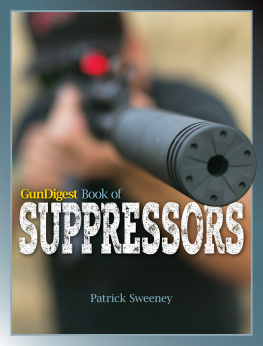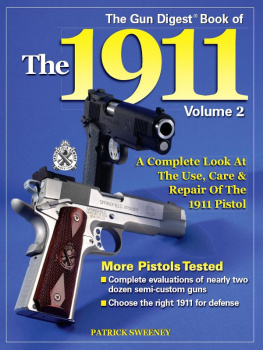First, to the men and women who have used the 1911, the 1911A1 and all its variants to keep us safe. Starting from when Serial #1 1911 came off the line to today, a large number of people have put themselves in harm's way for our well-being. From the Army, Navy, Marines, Air Force, and Coast Guard to police officers and individual citizens, the 1911 has been protecting us for a century.
Thank you.
And for me, the protection against bad things (at least, those not requiring ballistic intervention) comes from Felicia. With her, our three poodles (the number recently went up) and you, my readers, I'm feeling safe.
So thanks to you, too.
A CKNOWLEDGMENTS
First of all, to all the various gunsmiths, shooters, collectors and dealers I've worked with (or competed against) over the years, for the stories, information, tips, tricks and odd bits of lore I've learned.
In particular, for this book, I'd like to thank Bill Wilson, for background info and his most-excellent guns. The Rock Island Auction house, and Matt Parise, for the photos they provided, as well as Joe Salter of Down East Antiques.
Wayne Novak left me alone for a day with his collection, a camera, and access to the refrigerator full of caffeinated beverages although the Rottweilers would have had something to say had I tried to sneak over the fence with anything. And I still haven't been able to break the gun he built for me.
Ken Hackathorn had some even-rarer guns and background info. Known for his handlebar mustache, I have to say I had mine grown before I ever saw a photo of him. You would be hard-pressed to find someone who knows more people, and more about the guns involved, in the law enforcement and tactical world. Thanks, Ken.
Brandon Strayer of Infinity sent me a pistol so quickly that I can't tell you. No, I'm not kidding, I can't tell you, because he is backlogged to forever as one IPSC shooter puts it, and more than one world champion was put back a day or two for your reading and photographic pleasure.
Stan Chen, Ted Yost, Jason Burton, Ned Christiansen and Bill Laughridge provided me with guns, info and through the years, friendship.
The gun makers who helped out include Dwight Van Brunt of Kimber, Jason Morton of Dan Wesson/CZ, Richard Churchill and Jeff Radziwon of Colt, Les Baer, Ed Brown, Craig Gholson of Nighthawk, and Gary Smith of Caspian.
Hilton Yam of 10-8 consulting was most helpful, and Ivan Wolcott of Armscor and Theresa Starnes of Doublestar have been more than helpful through the years. Dave Williams of Spring-field is a bottomless well of 1911 info, and I have known Kerby Smith since 1990, when I first shot at the Steel Challenge. And Dave Skinner of STI? The only man I know who has had a more-varied and stranger career path than my own.
And thanks to Paul Pluff of S&W, for the tour of the plant, the answers to endless questions, and an insight into what it takes to produce a forged set of parts.
My apologies if there is anyone I've forgotten, as my time grows short on this project and my memory has been so-ravaged by the caffeine dosage needed that some days I have to look at my driver's license to remember who I am and where I live.
Thank you all.
I NTRODUCTION
Allow me to introduce myself. For a bunch of you, I am already known. For new readers, I am a name on the shelf. I began shooting back in the 1960s (yes, I'm old) and learned by doing. Alas, the first handgun I shot was not a 1911. It was, of all things, a Dickson Cheyenne, a German-made .22LR revolver. Not the greatest of guns, and one the family shot so much we wore it out but it was a start.
The next (and still going to this day) was a Ruger Blackhawk in .357 Magnum. I learned to shoot that, and reload for it, and from there things just kept going.
By the mid-1970s I was a shooter and reloader, feeding a Colt Diamondback with a single-stage press. I had been reading Guns & Ammo magazine religiously since the very early 1970s and had been keeping abreast of the changes in shooting. I had not heard about the Columbia conference, the formation of IPSC, until after it happened. In September of 1977, I shot in my first IPSC match. I won. I was hooked. I had started working at a gun shop in 1976, the Bicentennial year, and as a result I had access to lots of info and all the firearms my meager income could command. I also managed to read all the back issues of Guns & Ammo, and most of the American Rifleman newer than the Korean War. As a bonus, a collection of guns we bought at the gun shop included a collection of Gun Digests, going back to the mid-1950s, another bonanza of information! A surplus Ithaca 1911A1 pistol came to the shop, and I quickly snapped it up. I already knew that a box-stock 1911A1 wouldn't be competitive in IPSC competition, and even if it was, who wanted to be stock? So I had the local wizard gun-plumber, Frank Paris, work it over.
Since then, things have changed a lot, and we've learned a lot.
One thing you'll have to get used to in my style is the personal approach, especially in this book, where a lot of what I'm discussing were things that I did, or was next to the guys who did it, or talked to the guys who did it. I will, however, from time to time use the editorial we as in we did this, or we learned that. Do not be confused: I am not saying I was standing next to Jeff Cooper when in 1977 we learned that a 9mm was hard-pressed to keep up with a .45 in the scoring system. I'm merely saying that the knowledge was quickly disseminated and the lesson learned so thoroughly that it is now something everyone knows. (Which makes it ripe for re-assessment.)

I bopped from gun shop to radio broadcasting and back to a gun shop while still doing on air radio, this time as an apprentice to a master gunsmith: Dan McDonald. I learned a lot, and when he retired (early, in the opinion of many) I worked for the new owner of the shop. Soon after came another change of hands, and I was pretty much on my own. Working as a self-employed gunsmith offers a lot of opportunities: the chance to work long hours, delving into the intricacies of many firearms; to drink huge amounts of coffee (OK, that one I learned from radio); and to seriously ignore one's social life. And to shoot vast amounts of ammunition.

















